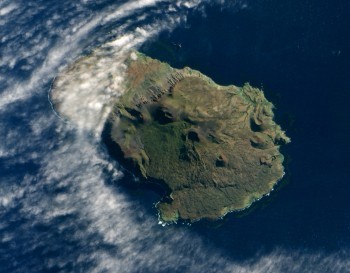
NASA Earth Observer 1 ALI satellite photograph
Prince Edward Island is the smaller of the two Prince Edward Islands, South African property in the southern Indian Ocean. Unlike its larger neighbour with its year-round weather and research station, Marion Prince Edward is uninhabited and is only visited by researchers at four-year intervals to reduce the risks of introducing alien species. No tourism is allowed. The Prince Edward Islands are a Special Nature Reserve, a Ramsar Wetland of International Importance since 2007 and are surrounded by a recently declared large Marine Protected Area. The islands’ 1996 management plan is to be replaced by a new plan that is waiting on formal adoption.
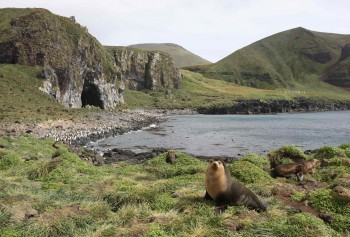
Photograph by Peter Ryan
The photo above shows the Annexation Cave with its 1948 flagpole at Cave Bay. Across the bay and behind the Subantarctic Fur Seal Arctocephalus tropicalis can just be discerned a tented camp.
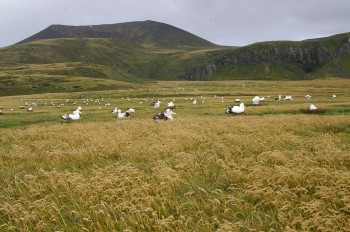
Photograph by Bruce Dyer
Prince Edward Island supports nine regularly breeding ACAP-listed species: five albatrosses and four petrels. For its size it has a large number (approaching one quarter of the World population) of breeding Wandering Albatrosses Diomedea exulans, notably in Albatross Valley, as shown here, and on the west coast where the birds breed at high densities.
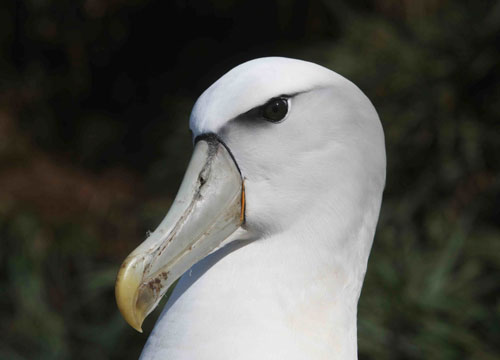
Photograph by Peter Ryan
A “Shy-type” Albatross (thought probably to be a White-capped Thalassarche steadi) was found incubating on Prince Edward in a mixed colony of Grey-headed T. chrysostoma and Indian Yellow-nosed T. carteri Albatrosses in December 2008, making it the 10th ACAP-listed species recorded on the island. Its partner is unknown (click here).
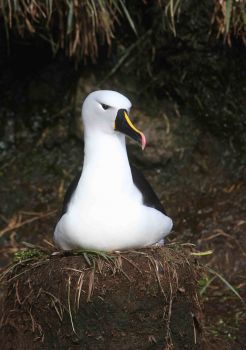
Photograph by Peter Ryan
With no House Mice Mus musculus on the island (unlike Marion), the grasses seed profusely and so the vegetation in the Indian Yellow-nosed Albatross colony is lush.
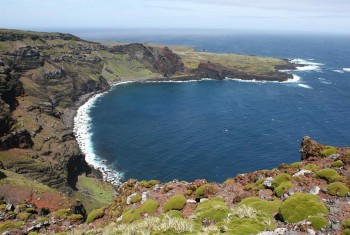
Photograph by Peter Ryan
Both Sooty Phoebastria fusca and Light-mantled Sooty P. palpebrata breed on the coastal cliffs of Prince Edward, including here above McNish Bay in the south-west of the island. The remaining ACAP-breeding species are the two giant petrels Macronectes spp. and the Grey Procellaria cinerea and White-chinned Petrel P. aequinoctialis.
With thanks to Bruce Dyer and Peter Ryan for photographs.
Selected References:
Chown, S.L. & Froneman, P.W. (Eds) 2008. The Prince Edward Islands: Land-Sea Interactions in a Changing Ecosystem. Stellenbosch: Sun PReSS.
Cooper, J. (Ed.). 2003. Seabirds and seals at the PrinceEdwardIslands. African Journal of Marine Science 25: 415-562.
De Villiers, M.S. & Cooper, J. 2008. Conservation and management. In: Chown, S.L. & Froneman, P.W. (Eds). The Prince Edward Islands: Land-Sea Interactions in a Changing Ecosystem. Stellenbosch: Sun PReSS. pp. 113-131.
De Villiers, M.S., Chown, S.L. & Cooper, J. 2011. Prince Edward Islands Conservation Handbook. Stellenbosch: SUN PRESS. 80 pp.
Lombard, A.T., Reyers, B., Schonegevel, L.Y., Cooper, J., Smith-Adao, L.B., Nel, D.C., Froneman, P.W., Ansorge, I.J., Bester, M.N., Tosh, C.A., Strauss, T., Akkers, T., Gon. O., Leslie, R.W. & Chown, S.L. 2007. Conserving pattern and process in the Southern Ocean: designing a Marine Protected Area for the Prince Edward Islands. Antarctic Science 19: 39-54.
Prince Edward Islands Management Plan Working Group 1996. Prince Edward Islands Management Plan. Pretoria: Department of Environmental Affairs & Tourism. 64 pp.
Ryan, P.G. 2009. Sixth albatross breeding on Prince Edward Island. Africa Birds & Birding 14(2): 14.
Ryan, P.G., Cooper, J., Dyer, B.M., Underhill, L.G., Crawford, R.J.M. & Bester, M.N. 2003. Counts of surface-nesting seabirds breeding at Prince Edward Island, summer 2001/02. African Journal of Marine Science 25: 441-451.
Ryan, P.G., Jones, M.G.W., Dyer, B.M., Upfold, L. & Crawford, R.J.M. 2009. Recent population estimates and trends in numbers of albatrosses and giant petrels breeding at the sub-Antarctic Prince Edward Islands. African Journal of Marine Science 31: 409-417.
Terauds, A., Cooper, J., Chown, S.L. & Ryan, P. 2010. Marion & Prince Edward. Africa’s Southern Islands. Stellenbosch: SUN PReSS. 176 pp.
John Cooper, ACAP Information Officer, 17 April 2013

 English
English  Français
Français  Español
Español